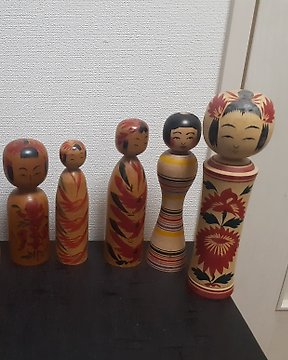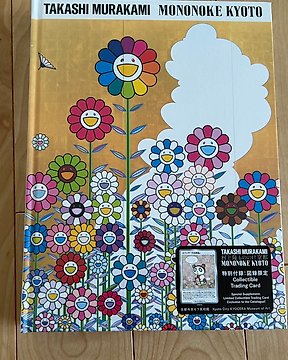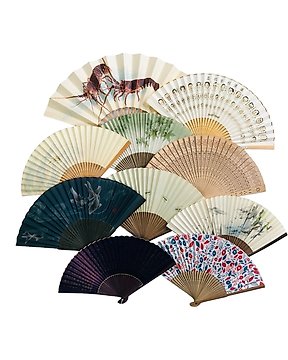Parfait : merci !
查看翻译日本能乐面具 - 木, 石头, 磯谷智麿 - 破魔瓦 驱鬼瓦
编号 87307673



*破魔瓦 鬼瓦 越前 北ノ庄
Demon-repelling tiles, demon tiles, Echizen Kitanosho
鬼瓦Onigawara are tiles that are attached to the end of the ridge to protect against rain. Older tiles with fewer bumps are sometimes called oniita. Generally, onigawara refers to the functional tiles attached to the end of the ridge tile, regardless of whether they have a demon face or not. Ridge end decorative tiles are also used to indicate their function, but this is not common. The demon motif attached to onigawara is said to ward off evil (evil spirits).
In ancient Japan, lotus motifs were common, but after the Nara period, demon faces became mainstream, and they came to be called onigawara. Later, they came to be called onigawara even without a demon face.
Size: mask 12*18*5cm
back panel 24.5*30*1.5cm
*Hayakawa Ami was born in Niigata Prefecture and worked as a sculptor.
1912: Born on January 25th in Ryugashima, Niigata City as the eldest son of sculptor Hayakawa Taiichiro (Futai).
1924: Graduated from Kamitsuchigame Elementary School, Toyosaka City.
1926: Entered the sculpture department of the Japan Art School, studying under Fujii Koji, and from this time became fascinated with Noh masks.
1931: Graduated from the same school, entered Banshujuku, and studied under Fujikawa Yuzo, devoting himself to his creations.
1934: Traveled to Taiwan.
1936: Released a series of works, including "Dancing Aboriginal Woman," bringing a breath of fresh air to the Taiwanese sculpture world.
Established the sculpture department of the Taiwan Art Federation Exhibition, and held a traveling exhibition for the whole of Taiwan twice a year, during which time he created over 30 bronze portraits.
1941: Conscripted to serve on the southern front.
1947: After being demobilized from Java, built an atelier in Niigata City and began creating plaster sculptures. Since then, he has pursued his own unique artistic path without belonging to any sculpting school. He was attracted to Ryokan and began working on a statue of him.
1960: He became absorbed in the study and production of primitive pottery such as flame pottery.
1963: He built a torch (flame pottery type) for the Niigata National Athletic Meet.
1968: He built an atelier on the former site of the Mase Copper Mine smelter.
1970: He conceived the idea of a sacred park in Mase Village and built his long-cherished "Echigo Nanaura Kannon".
He was involved in the creation of the Olympic cauldron for the Niigata National Athletic Meet, and this work is still enshrined in the front garden of Niigata Prefectural Civic Center after it was repaired following the Niigata earthquake.
His work, the "Michibiki Statue," is also in the front garden of Niigata Prefectural Civic Center. After the war, when the copper mine closed, Mase was poor, and the men worked as "Mase carpenters" and the fishermen left to work.
Hayakawa Ami worked hard to build an art village, immersing herself in creating artworks in his studio.
However, his health deteriorated, and the art village never came to fruition. All that remains are the abandoned house and the moss-covered objects.
*Noh masks have such a delicate and profound charm that their facial expressions change subtly depending on the viewing angle and the way the light hits them, and there is an anecdote that ``the heart dwells in them.''There are approximately 80 types of Noh masks used on Noh stages. The material is pounded with cypress wood and carved with chisels and various chisels. The surface is coated with gofun dissolved in glue and carefully polished with sandpaper. The eyes, eyebrows, and hair are drawn with ink, and the lips are created with vermillion ink or red.
Noh masks are a craft that combines ``sculpture'' and ``painting,'' and requires various techniques such as lacquering the back, metalwork for the eyes and teeth, and flocking for the hair and beard.
Shipped by Japan Post, our shipping cost includes packaging.
Customs information
Antique items have originally crease, stain, damage, and more.
Please refer to the listing photos, but please understand that it's difficult to show all conditions by the photos.
Any other costs or charges such as customs or import duties,
customs clearance and handling may also apply during the shipment of your lot and will be charged to you by the involved party at a later stage if applicable.
Please understand!
*破魔瓦 鬼瓦 越前 北ノ庄
Demon-repelling tiles, demon tiles, Echizen Kitanosho
鬼瓦Onigawara are tiles that are attached to the end of the ridge to protect against rain. Older tiles with fewer bumps are sometimes called oniita. Generally, onigawara refers to the functional tiles attached to the end of the ridge tile, regardless of whether they have a demon face or not. Ridge end decorative tiles are also used to indicate their function, but this is not common. The demon motif attached to onigawara is said to ward off evil (evil spirits).
In ancient Japan, lotus motifs were common, but after the Nara period, demon faces became mainstream, and they came to be called onigawara. Later, they came to be called onigawara even without a demon face.
Size: mask 12*18*5cm
back panel 24.5*30*1.5cm
*Hayakawa Ami was born in Niigata Prefecture and worked as a sculptor.
1912: Born on January 25th in Ryugashima, Niigata City as the eldest son of sculptor Hayakawa Taiichiro (Futai).
1924: Graduated from Kamitsuchigame Elementary School, Toyosaka City.
1926: Entered the sculpture department of the Japan Art School, studying under Fujii Koji, and from this time became fascinated with Noh masks.
1931: Graduated from the same school, entered Banshujuku, and studied under Fujikawa Yuzo, devoting himself to his creations.
1934: Traveled to Taiwan.
1936: Released a series of works, including "Dancing Aboriginal Woman," bringing a breath of fresh air to the Taiwanese sculpture world.
Established the sculpture department of the Taiwan Art Federation Exhibition, and held a traveling exhibition for the whole of Taiwan twice a year, during which time he created over 30 bronze portraits.
1941: Conscripted to serve on the southern front.
1947: After being demobilized from Java, built an atelier in Niigata City and began creating plaster sculptures. Since then, he has pursued his own unique artistic path without belonging to any sculpting school. He was attracted to Ryokan and began working on a statue of him.
1960: He became absorbed in the study and production of primitive pottery such as flame pottery.
1963: He built a torch (flame pottery type) for the Niigata National Athletic Meet.
1968: He built an atelier on the former site of the Mase Copper Mine smelter.
1970: He conceived the idea of a sacred park in Mase Village and built his long-cherished "Echigo Nanaura Kannon".
He was involved in the creation of the Olympic cauldron for the Niigata National Athletic Meet, and this work is still enshrined in the front garden of Niigata Prefectural Civic Center after it was repaired following the Niigata earthquake.
His work, the "Michibiki Statue," is also in the front garden of Niigata Prefectural Civic Center. After the war, when the copper mine closed, Mase was poor, and the men worked as "Mase carpenters" and the fishermen left to work.
Hayakawa Ami worked hard to build an art village, immersing herself in creating artworks in his studio.
However, his health deteriorated, and the art village never came to fruition. All that remains are the abandoned house and the moss-covered objects.
*Noh masks have such a delicate and profound charm that their facial expressions change subtly depending on the viewing angle and the way the light hits them, and there is an anecdote that ``the heart dwells in them.''There are approximately 80 types of Noh masks used on Noh stages. The material is pounded with cypress wood and carved with chisels and various chisels. The surface is coated with gofun dissolved in glue and carefully polished with sandpaper. The eyes, eyebrows, and hair are drawn with ink, and the lips are created with vermillion ink or red.
Noh masks are a craft that combines ``sculpture'' and ``painting,'' and requires various techniques such as lacquering the back, metalwork for the eyes and teeth, and flocking for the hair and beard.
Shipped by Japan Post, our shipping cost includes packaging.
Customs information
Antique items have originally crease, stain, damage, and more.
Please refer to the listing photos, but please understand that it's difficult to show all conditions by the photos.
Any other costs or charges such as customs or import duties,
customs clearance and handling may also apply during the shipment of your lot and will be charged to you by the involved party at a later stage if applicable.
Please understand!
- 66
- 0
- 2
Just perfect! Thank you
查看翻译Quick Delivery and very well wrapped. We are very happy with this item!
查看翻译Rare item but I paid €75 for non-urgent shipping of a small package to the Netherlands, about €40 too much The seller says he charged these costs for packing! There's no buyer protection from Catawiki
查看翻译Precioso. Más hermoso de lo que creía. Un poco caro los gastos de envío. Saludos
查看翻译Superbe masque No. Il n'est pas en bois mais en céramique donc plus fragile, mais cela lui donne une expression incroyablement humaine, troublante. Un objet fascinant. Arrivé très bien emballé.
查看翻译All was perfectly packed and exactely what was offered. I am very happy.
查看翻译Item looks exactly like the pictures. It was shipped fast and carefully wrapped. Thank you!
查看翻译A beautiful painting! Very well packed! Domo arigato gozaimasta!!!
查看翻译Top 😊
查看翻译Great lot thanks
查看翻译RAS. Livraison nickel
查看翻译Conforme à l'annonce , reçu très rapidement et très bien emballé . Merci.
查看翻译Genau so ein Stück habe ich gesucht. Sehr gut und sorgfältig verpackt.
查看翻译Arrivate ben confezionate e in tempi brevissimi. Anche le foto erano veritiere e ben fatte.
查看翻译Item was meticulously protected, befitting of the Japanese reputation. Highly recommended.
查看翻译Fine print, safe packaging, quick delivery. Many thanks ! Claval, France (EU)
查看翻译Wunderschön!
查看翻译L'objet était conforme aux photos et a été très bien emballé. Je recommande ce marchand.
查看翻译Very well taken care of.
查看翻译Produit conforme. Livraison parfaite. Merci
查看翻译Ottimo imballo e consegna, l'unica cosa che mi sono stati chiesti ulteriori 12 euro alla consegna
查看翻译Très bel ensemble de bols qui nous permettrons de goûter encore mieux la cuisine japonaise que nous apprécions beaucoup Alligato
查看翻译ottimo imballaggio e ottime condizioni. trattativa perfetta. bellissima opera
查看翻译Schnelle Lieferung mit sehr sorgfältiger Einpackung. Die Sammlung ist genau wie Beschreibung. Ich bin sehr damit zufrieden! Vielen Dank und gern wieder!
查看翻译








